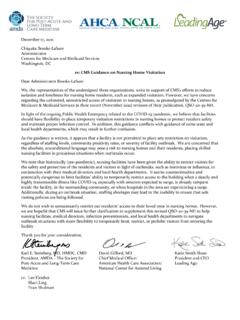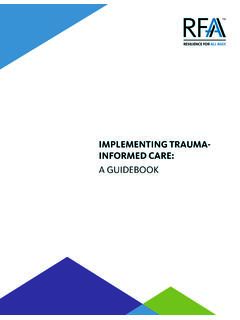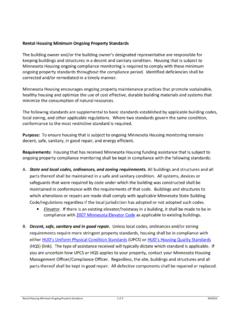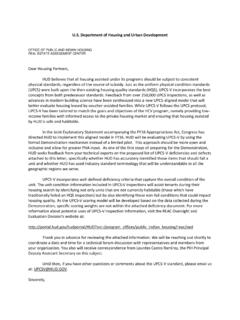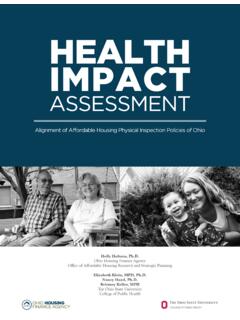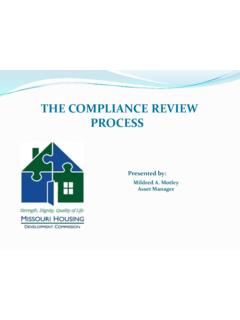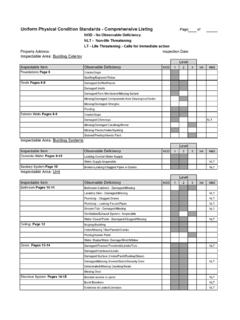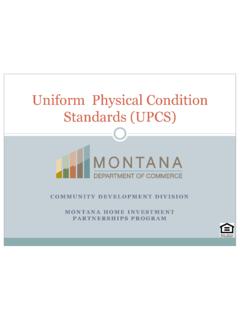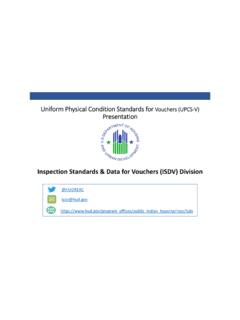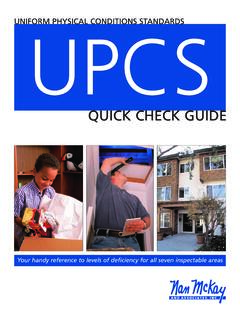Transcription of Fact Sheet: REAC Physical Inspections
1 Fact Sheet: REAC Physical Inspections A Review of Protocol Changes and Current Expectations In 1998, the Department of Housing and Urban Development (HUD) began doing Physical Inspections for all Section 8 housing, public housing, HUD-insured multifamily housing, and other HUD assisted housing (collectively, HUD housing) using a defined uniform Physical condition standards to ensure that the housing is decent, safe, sanitary and in good repair. This was the first effort at centralized collection of standardized electronic reporting under the auspices of the HUD Real Estate Assessment Center (REAC) s Physical assessment subsystem. Since its inception, the REAC Physical inspection protocol, definitions and online platform that support it have undergone formalized changes. Additionally, several updates have been made to a document referred to as the compilation bulletin - a collection of memos and other UPCS guidance and protocol clarifications shared with inspectors.
2 Most recently, with the expanded protocol under REAC s Industry Standard rules, new rules of behavior for REAC Inspectors, changes to oversight on Quality Assurance on REAC, and new laws that govern what happens when a property fails its REAC Inspection Inspectors, expectations for and experiences related to REAC Inspections have changed dramatically. Following is a summary of the major issues members should be aware of including owner/agent rights related to scheduling, stopping a review in process, appealing unwarranted deficiency findings and/or responding to exigent health and safety violations. Background The HUD REAC has centralized the collection of electronic data used in the assessment of all HUD housing. Since the launch of the REAC Physical inspection protocol in 1998, there have been revisions to more than half of the definitions, periodic clarifications on how to interpret/apply the definitions, and several changes in policy regarding inspection reporting, oversight and appeals processes.
3 Responsibility for REAC operations and administration was transferred to the Office of Public and Indian Housing (PIH) in 2002. Over time, PIH-REAC enhanced and routinized quality assurance reviews and centralized inspector training and certification so it is handled exclusively by REAC staff on-site at the REAC offices. LeadingAge (then known as AAHSA) was an active participant in the development of the initial REAC Physical inspection protocol, as well as a key player in stimulating substantial revisions during the first two years. Then as now, LeadingAge will provide technical assistance to any LeadingAge Fact Sheet REAC Physical Inspections March 2018; page 2 member with questions or concerns about their individual Inspections , and continue to collaborate with HUD and other stakeholders to address changes made or needed to the protocol to improve its reliability, consistency, proportionality, and relevance based on this communications from members.
4 Summary Following is an overview of the protocol, what owners can expect from scheduling the inspection to receiving the final score, including a review of owner obligations for responding to an inspection, highlights of some of the major changes to the protocol over the years, new methods for filing EH&S certifications, and important information on how to file an appeal. Useful on-line resources and getting personalized help are also covered. Frequency of Inspections Inspections are conducted on a risk-adjusted (3-2-1) basis. Under this policy, Inspections occur annually, unless the most recent score was 80 (out of 100) or higher. Properties receiving a score of 80 89 are inspected every two years; properties receiving a score of 90 or more are inspected every three years. For more on the administrative processes and timing of Inspections , see the December 8, 2000, final rule.
5 Scheduling, Preparing for the Inspection An inspection notification letter will be sent by mail to the owner, advising the owner an inspection company representative will be calling shortly to arrange a mutually convenient date to conduct the inspection. Owners have the right to negotiate the actual date and time. If major rehabilitation work is underway, an inspection after the date of completion may be advisable. Requests for postponement should be directed to the local HUD office as soon as possible. However, as Inspections are mandated to occur within 9 to 15 months of the most recent inspection anniversary, and before the end of the inspection firm s contract year with HUD, owners are encouraged to do their best to accommodate the initially scheduled date. Read more about the guidance provided to the inspector regarding scheduling. The notification instructs owners to make available all applicable certifications including Inspections of elevators, sprinkler systems, fire alarms, and boilers.
6 For housing built prior to 1978, lead-based paint inspection reports will also be requested, though this program does not apply to housing for older adults. A list of modifications made to residential units in response to reasonable accommodation requests should also be offered to the inspector on his/her arrival. Don t forget to measure off separately all total area measures for parking lots/driveways/roads and walkways/steps which will be used for proportionality calculations for deficiencies in these areas. LeadingAge Fact Sheet REAC Physical Inspections March 2018; page 3 Software is available for owners to download/use on their own computers to check out the system or do a pre-test survey of their own facilities. This 100% inspection can be completed using the DCD Public Version Software of the inspection software, which is available for download from the REAC website if you choose to complete the inspection electronically.
7 To get a sense of likely finding not using the electronic platform, use the Revised Dictionary of Deficiency Definitions. The Inspection Day Inspectors are required to identify themselves to the owner/site staff immediately upon arrival. They must wear identification and be accompanied by a project representative at all times. Inspectors can only begin the actual inspection and generate the list of sample units to be inspected after having a site representative first confirming all project data and contact information contained on the hand-held inspection recording device. Units to be inspected shall not be identified in advance, unless the project units are not master-keyed. HUD has created a REAC inspection checklist to ensure that the inspection is conducted in a thorough and consistent manner. NOTE: If an inspector does not appear in a timely manner or conducts themselves in an egregiously unprofessional or inappropriate manner towards staff or residents, property management has the right to put an immediate stop to the inspection and may do so by contacting the REAC Technical Assistance Center at 1-888-245-4860.
8 During the inspection, the inspector is required to call out all deficiencies as they are recorded in the handheld device, so the accompanying project representative may make note of deficiencies needing attention. This is not an opportunity to argue the matter, and the inspector is allowed to stop calling out deficiencies if they are prevented from moving forward with their inspection by repeated challenges. However, if the site representative feels a deficiency is wrong, special note should be taken so appropriate review and documentation may be prepared to file a challenge later in writing, if merited. REAC has suggested that owners may want to carry a digital or video camera to record the condition of the property and deficiencies as noted during the inspection to serve as visual evidence for an appeal if one is required (see Filing an Appeal below). Be sure visual images are taken during the inspection with date-stamp feature enabled.
9 According to the REAC inspector training protocol, there are only three things an owner may do during the inspection which could impact the potential scoring or notation or a deficiency: light pilot lights, insert bulbs, or plug in exhaust fans to show that they work. Other repairs done during the inspection will not prevent deficiencies from being recorded. LeadingAge Fact Sheet REAC Physical Inspections March 2018; page 4 Property representative may be required to test items more than 8 above the floor (such as smoke detectors, emergency lighting and exit signs) and shall be required to turn stoves or ovens on and off in the presence of an inspector. Quality Assurance Over time, the method and manner of the inspector has come under scrutiny as their performance is a critical component in assuring consistency in inspection results. New quality assurance protocols are being put into place requiring each inspector to be accompanied by a Quality Assurance (QA) reviewer on a routine basis, with expectations that this will be no less than 2 times each year.
10 QA staff accompany inspectors during the actual inspection more frequently now than in the past, when they would perform follow-up Inspections within 24 to 48 hours. On-going disagreements or escalating arguments between inspector and QA reviewer about deficiency definitions or applications are generally not considered appropriate and excessive discussion or detrimental impacts on the site inspection should be reported by contacting the REAC Technical Assistance Center at 1-888-245-4860. Current software imbedded in the inspection data recordation device now make time-stamped entries for each action/entry noted by the inspector, so REAC QA staff can better assess the time each inspector is spending on site, reviewing each component, in each unit, etc. Too much or too little time inspecting given components will trigger follow-up assessment by PIH-REAC staff in Washington, DC.
